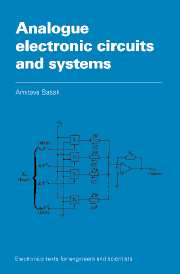2 - Transistor circuit techniques and amplifiers
Published online by Cambridge University Press: 05 June 2012
Summary
Objectives
At the end of the study of this chapter a student should be:
familiar with the operation of the differential amplifier, its voltage gain, common-mode gain and common-mode rejection ratio
familiar with constant current sources and current mirror circuits
capable of explaining the principle of Darlington connections
able to design level shifting circuits
familiar with multistage amplifiers and able to calculate their input and output impedances and overall current and voltage gains
able to design class A, class B and tuned amplifiers
familiar with different types of heat sinks and able to choose the right heat sink for a particular circuit
Linear integrated circuits
Complete multistage amplifiers and other linear devices can be constructed on a single chip of silicon occupying a very small volume by using modern techniques for the fabrication of integrated circuits. In the case of monolithic integrated circuits, all components may be manufactured on the chip by a diffusion process. A diffusion isolating technique is used to separate the various components from each other electrically. The design techniques used for the construction of these integrated circuits are basically the same as those used to build circuits employing discrete components, although, in many cases some modification in techniques is needed.
The operational amplifier is the most common type of integrated circuit (small scale integration) which is widely used with different forms of external circuitry to build summers, subtractors, integrators, filters, etc.
- Type
- Chapter
- Information
- Analogue Electronic Circuits and Systems , pp. 4 - 58Publisher: Cambridge University PressPrint publication year: 1991



